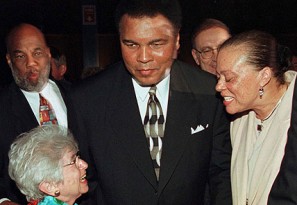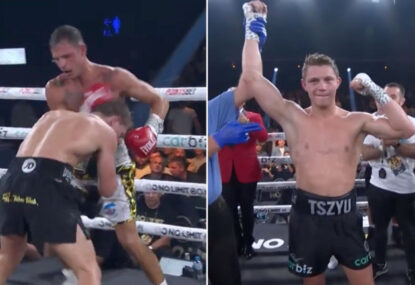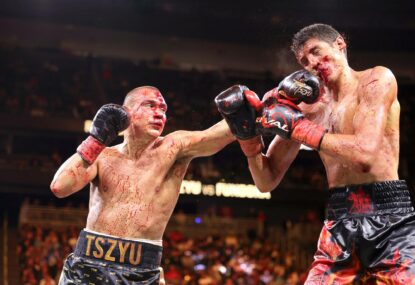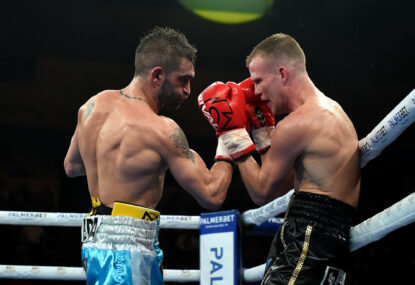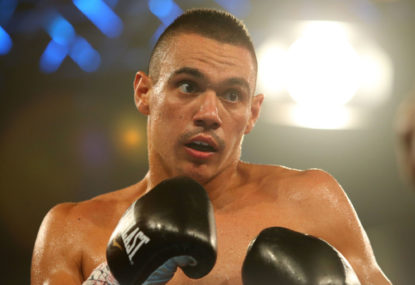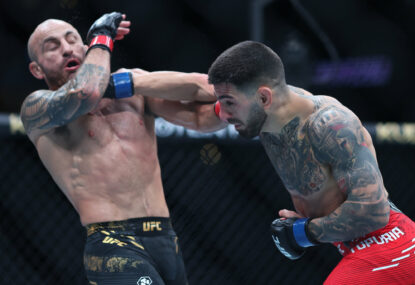In Thrilla In Manila (2008) – a film about the third and last bout between Muhammad Ali and Joe Frazier in 1975 – Ali’s own biographer and Pulitzer Prize nominee Thomas Hauser said: “In the ring Frazier and Ali were the equal of each other yet today Ali has sold the use of his name and likeness for fifty million dollars.
“Joe is living in a room above his gym in Philadelphia. That’s an interesting look at how America treats its sporting icons. Some are accorded special status. Others are largely forgotten”.
America, awestruck by the charismatic showman and shameless self promoter Ali, forgot all about poor Smokin’ Joe.
They forgot what he did to the World’s Greatest Athlete in Madison Square Garden in March 1971 when he exposed a weakness in Ali’s armoury, opening him up with vicious left hooks. They forgot about it because Ali and his trainer Angelo Dundee claimed Frazier’s points decision victory was a sham – reflecting the white bias towards him.
Some critics claim the film is compromised by its use of this fight to denigrate Ali with its focus on his activism, involvement with the Nation of Islam and treatment of Frazier.
But some of the lines uttered in this doco – a superb depiction of boxing and human nature – are as devastating as the hits dished out by the two immortal heavyweights.
It was during the Thrilla In Manila four years later that Ali felt, for the first time in his career, that he was going to die. That was enough to make it the greatest fight ever. But there was much more to it than that.
Ali’s physician and cornerman Ferdie Pacheco never had cause to be concerned for his client’s welfare until that unbearably hot and humid morning of October 1st, 1975 inside the Araneta Colosseum in the Philippines.
After dominating a “washed up” Joe Frazier in the early rounds Ali suddenly found himself in serious trouble. Frazier started to work over Ali’s brain and other vital organs during six rounds of brutal left and right hooks, and shuddering body blows.
After the fifth round Ali was no longer taunting Frazier with nursery rhymes, and after the tenth – his bright mocking eyes dulled by pain, exhaustion and internal bleeding (he would soon be peeing blood) – he confided ringside: “This is what death must be like”.
Throughout this fight , Ali resurrected himself once, Frazier twice. And then after the fourteenth round when Ali had had enough and was asking his trainer to end it, Frazier’s threw in the towel.
Hauser said “Great fights between great fighters are few and far between”. When those fighters are heavyweights, people who claim not to like boxing come to watch.
Norman Mailer observed that when Ali appeared in public “women would draw an audible breath. Men would look down”. On television the charisma is not as apparent. In fact it was Frazier (the “ugly gorilla” as Ali unforgettably and unforgivably called him) who most resembled cinema’s first black action hero, the ruggedly handsome Shaft
You see, as the documentary makes clear from the opening, the fight was personal. Frazier resented Ali, and rightly so. They had once been close friends. Frazier had lent Ali money when he was banned for boxing for refusing to serve in Vietnam and Frazier actively petitioned for the reinstatement of Ali’s licence.
When the Supreme Court lifted the ban and the Madison Square Garden fight was set up the relationship changed dramatically. Ali was a renowned witty taunter of opponents that served to put them off their game and to increase interest in the fights. He was an invigorating presence in a deadly earnest profession.
He chose to give his one time friend searingly cruel and personal insults, referring to him as a “fat-nosed ugly pug” and absurdly labelling him a black traitor because of his white business interests. Later, ironically, would come the insult usually attributed to racist whites: “Gorilla”.
The narrator explains Ali’s motives: “Of the forty-nine fighters Muhammad Ali fought during his twenty year career Joe Frazier was the one he feared the most. And Ali did everything he could to unsettle him”.
Frazier was clearly shaken by the outbursts. Lacking Ali’s verbal facilities he was unable to counter the insults by pointing out Ali’s hypocritical lifestyle. Instead, his friend’s betrayal burning inside him, he grew to hate Ali.
So much so that during the film – thirty-three years after the Thrilla In Manila – he revels in the possibility that God and the battering he gave Ali between rounds five and ten are responsible for Ali’s degenerative condition.
It seems Ali’s ugly tirades had unearthed something ugly in this once genial giant.
Only Joe Frazier, it seems, knew what was coming in the Philippines. Ali had sensationally knocked out George Foreman the previous year in The Rumble In The Jungle and seemed to be at the top of his game.
Frazier,on the other hand, had been battered senseless by Foreman inside two rounds and was thought by Ali to be finished.
Ali spent the days cavorting with his mistress and making public appearances. Frazier, with a single minder, escaped to the outskirts of Quezon City to train, focus and nurture his hatred.
As early as the fighters’ entrance, things started to get out of kilter for Ali. The Filipinos had tired of Ali’s verbal taunts and began to boo him. Ali showed mock outrage and carried the trophy over to his corner. It’s hard to believe, watching that pantomime now, what was to follow.
Ali believed he could end it inside five rounds. Trying to exploit Frazier’s renowned slow starts Ali spurned his dancing, and walked straight on in. For the first three rounds the world saw the greatest looking fighter at his best – the aesthete of combinations – as he worked on Frazier’s face. Ali’s ferocious pace didn’t allow his opponent to get under and in, like he had in New York.
It went on for three rounds but as his cornerman relates: “Ali, for some reason couldn’t do it, He was hitting him with the best hits he could and it wasn’t hurting… as much as it should”.
Then in the fourth Frazier found Ali with a right, and then another. Someone says: “I didn’t think Joe could tie his shoes with his right hand. Suddenly Ali is thinking there are two hands in this fight. That was very important”.
And so began the assault on Ali’s person as Frazier expressed his hatred upon his opponent’s heart, liver and kidneys. “He wasn’t just beating Ali. He was beating Ali …up! Big difference”, says Hauser.
Even Imelda Marcos, the wife of a dictator and probably no stranger to distressing noises, couldn’t bear to watch “because you could hear the sounds. When the fists would land.”
Ali was unmarked but not unaffected. He was bleeding inside but more importantly the hooks he had absorbed from the shorter more powerful Frazier were caught on the up, striking his chin and jaw – throwing his head back and forcing his brain against the inside of his skull.
Frazier may have had the swollen visage but the damage was more cosmetic. Ali’s jabs and straight rights had hit him flat; his face and pylon-thick neck disseminating the shock.
There are stills from that first bout in New York in 1971 ,”The Fight of the Century”, showing Frazier staggering Ali in the eleventh round and then knocking him down in the fifteenth. Frazier’s left arm and shoulder having completed their brutal task are following through and just as prominent are his muscular thighs: the starting point of the thunderbolt’s power.
Ali was the taller man – more mobile, slimmer, and with a longer reach. But there’s a price to pay for those advantages: a lack of power and a jaw vulnerable to attack. Ali was the most complete heavyweight boxer there had ever been but his power deficit and susceptibility to Frazier’s greatest weapon , the left hook, cost him their first confrontation and should have cost him their third.
But just as Frazier had done in the early rounds, Ali somehow survived the ordeal and began slowly to get back into the contest. By the thirteenth, Frazier, who was nearly blind in the left eye, was having trouble seeing out of his right. He was beginning to absorb Ali’s straight punches again.
Then came the fourteenth.
“If you had to say what’s the attraction of boxing you’d show them round fourteen. Do you want to see what makes people come and scream and holler? Look at round fourteen”, said Pacheco.
A correspondent believed “it was the most brutal of the fourteen rounds. There are five or six times when Ali throws combinations where you expect Joe to fall. And he staggers… but his will keeps him up”.
Pacheco said it was “the closest he’d seen somebody come to killing somebody”.
Before the start of the final round, the swollen face of Frazier can be seen arguing with trainer Eddie Futch. Ali, his face relatively unscathed, looks exhausted and has ordered Angelo Dundee to cut off his gloves. When Futch ends the fight Ali looks in shock. He rises slowly to celebrate but is soon on his back being attended to.
Ali’s doctor said his man should never have boxed again: “He was pissing blood. He can’t walk straight, he can’t talk straight, he can’t see straight … but he wanted to keep going”.
He would go on to fight ten more bouts, winning seven. He would lose his second last against ex sparring partner Larry Holmes. Holmes described it as “like taking candy from a baby”.
Ali viewed himself differently to most of his fellow boxers – poor, uneducated, witless, unimaginative, “victims of circumstance” – because boxing was all they knew, and cared about.
Ali wanted to be more than a boxer. He wanted to be an entertainer, an artist, an intellectual, an entrepreneur, a joker, and most importantly an activist – a man in control of his destiny. He became wealthy, worldly and idolised, and yet continued to box, probably damning himself to Parkinson’s.
Frazier would fight twice more, and then retire to the room in his gym with cans of corn and Campbell’s Chunky soup.
Sylvester Stallone used Frazier’s training methods – running up the stairs of Philadelphia’s Museum of Art and punching sides of beef – as inspiration for Rocky.
So what did the city do? It erected a statue of Rocky Balboa.
Sadly, Frazier passed away just four months ago from liver cancer. America should be judged on how they treat the legacy of this great heavyweight.





























































































